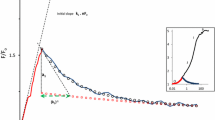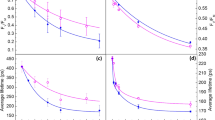Abstract
The generation of non-photochemical fluorescence quenching under photoinhibitory illumination and its relaxation under subsequent low light illumination in leaves from intermittent-light-grown pea (Pisum sativum L.) plants (IML-plants) has been investigated. In parallel, we studied (i) the activity of the xanthophyll cycle with emphasis on zeaxanthin formation and reconversion to violaxanthin and (ii) the degradation rate of D1 protein. In comparison to control plants grown in continuous light, IML-plants were much more susceptible to photoinhibition as determined from the increase of slowly (halftimes > 20 min) relaxing quenching (qI) of variable chlorophyll fluorescence. The relaxation (recovery) kinetics of qI (under weak light) in both types of plant depended on the photon flux density, temperature and duration of pre-illumination. The recovery time generally increased with an increasing degree of qI. In IML-plants, relaxation of qI was kinetically closely related to the epoxidation of zeaxanthin. At high degrees of photosystem II inhibition the kinetics resembled those of D1 degradation. The results are discussed in terms of the mechanisms of photosystem II inactivation in vivo.
Similar content being viewed by others
Abbreviations
- A:
-
antheraxanthin
- CAB protein:
-
chlorophyll a/b-binding protein
- Chl:
-
chlorophyll
- CL:
-
continuous light
- FM :
-
maximum fluorescence
- FV :
-
variable fluorescence
- IML:
-
intermittent light
- PFD:
-
photon flux density
- qE:
-
energy-dependent fluorescence quenching
- qI:
-
photoinhibitory fluorescence quenching
- SM:
-
streptomycin
- V:
-
violaxanthin
- Z:
-
zeaxanthin
References
Adams III WW, Demmig-Adams B (1994) Carotenoid composition and down regulation of photosystem II in three conifer species during the winter. Physiol Plant 92: 451–458
Allen JF (1992) Protein phosphorylation in regulation of photosynthesis. Biochim Biophys Acta 1098: 275–335
Aro E-M, Kettunen R, Tyystjärvi E (1992) ATP and light regulate D1 protein modification and degradation. FEBS Lett 297: 29–33
Aro E-M, Virgin I, Andersson B (1993) Photoinhibition of photosystem II. Inactivation, protein damage and turnover. Biochim Biophys Acta 1143: 113–134
Barbato R, Shipton CA, Giacometti GM, Barber J (1991) New evidence suggests that the initial photoinduced cleavage of the D1 protein may not occur near the PEST-sequence. FEBS Lett 290: 162–166
Bassi R, Pineau B, Dainese P, Marquardt J (1993) Carotenoidbinding proteins of photosystem II. Eur J Biochem 212: 297–303
Brugnoli E, Cona A, Lauteri M (1994) Xanthophyll cycle components and capacitiy for non-radiative energy dissipation in sun and shade leaves of Ligustrum ovalifolium exposed to conditions limiting photosynthesis. Photosynth Res 41: 451–463
Callahan FE, Becker DW, Cheniae GM (1986) Studies on the photoactivation of the water-oxidizing enzyme II. Characterization of weak light photoinhibition of PSII and its light-induced recovery. Plant Physiol 82: 261–268
De Las Rivas J, Andersson B, Barber J (1992) Two sites of primary degradation of the D1-protein induced by acceptor or donor side photoinhibition in photosystem II core complexes. FEBS Lett 301: 246–252
Demmig B, Winter K, Krüger A, Czygan F-C (1987) Photoinhibition and zeaxanthin formation in intact leaves. A possible role of the xanthophyll cycle in the dissipation of excess light. Plant Physiol 84: 218–224
Demmig-Adams B (1990) Carotenoids and photoprotection in plants: A role for the xanthophyll zeaxanthin. Biochim Biophys Acta 1020: 1–24
Demmig-Adams B, Adams WW (1992) Carotenoid composition in sun and shade leaves of plants with different life forms. Plant Cell Environ 15: 411–419
Demmig-Adams B, Adams WW (1993) The xanthophyll cycle, protein turnover and the high light tolerance of sun-acclimated leaves. Plant Physiol 103: 1413–1420
Engelbrecht S, Lill H, Junge W (1986) Reconstitution of CF1-depleted thylakoid membranes with complete and fragmented chloroplast ATPase. The role of the δ subunit for proton conduction through CF0. Eur J Biochem 160: 635–643
Falk S, Król M, Maxwell DP, Rezansoff DA, Gray GR, Huner NPA (1994) Changes in in vivo fluorescence quenching in rye and barley as a function of reduced PSII light harvesting antenna size. Physiol Plant 91: 551–558
Frank HA, Cua A, Chynwat V, Young A, Gosztola D, Wasielewski MR (1994) Photophysics of the carotenoids associated with the xanthophyll cycle in photosynthesis. Photosynth Res 41: 389–395
Gilmore AM, Björkman O (1994a) Adenine nucleotides and the xanthophyll cycle in leaves. I. Effects of CO2- and temperature-limited photosynthesis on adenylate energy charge and violaxanthin de-epoxidation. Planta 192: 526–536
Gilmore AM, Björkman O (1994b) Adenine nucleotides and the xanthophyll cycle in leaves. II. Comparison of the effects of CO2- and temperature-limited photosynthesis on photosystem II fluorescence quenching, the adenylate energy charge and violaxanthin de-epoxidation in cotton. Planta 192: 537–544
Gilmore AM, Yamamoto HY (1991) Resolution of lutein and zeaxanthin using a non-endcapped, lightly carbon-loaded C18 highperformance liquid chromatographic column. J Chromatogr 543: 137–145
Gilmore AM, Yamamoto HY (1992) Dark induction of zeaxanthindependent nonphotochemical fluorescence quenching mediated by ATP. Proc Natl Acad Sci USA 89: 1899–1903
Horton P, Ruban AV, Rees D, Pascal AA, Noctor G, Young AJ (1991) Control of the light-harvesting function of chloroplast membranes by aggregation of the LHCII chlorophyll protein complex. FEBS Lett 292: 1–4
Jahns P (1995) The xanthophyll cycle in intermittent light grown pea plants: possible functions of chlorophyll a/b binding proteins. Plant Physiol 108: 149–156
Jahns P, Junge W (1992) Thylakoids from pea seedlings grown under intermittent light: biochemical and flash-spectrophotometric properties. Biochemistry 31: 7390–7397
Jahns P, Krause GH (1994) Xanthophyll cycle and energy-dependent fluorescence quenching in leaves from pea plants grown under intermittent light. Planta 192: 176–182
Krause GH (1994) The role of oxygen in photoinhibition of photosynthesis. In: Foyer CH, Mullineaux PM (eds) Causes of photooxidative stress and amelioration of defense systems in plants. CRC press, Boca Raton, pp 43–76
Krause GH, Weis E (1991) Chlorophyll fluorescence and photosynthesis: the basics. Annu Rev Plant Physiol Plant Mol Biol 42: 313–349
Król M, Spangfort MD, Huner NPA, Öquist G, Gustafsson P, Jansson S (1995) Chlorophyll a/b binding proteins, pigment conversions and early light-induced proteins in a Chl b-less barley mutant. Plant Physiol 107: 873–883
Laemmli UK (1970) Cleavage of structural proteins during the assembly of the head of bacteriophage T4. Nature 227: 680–685
Leitsch J, Schnettger B, Critchley C, Krause GH (1994) Two mechanisms of recovery from photoinhibition in vivo: Reactivation of photosystem II related and unrelated to D1-protein turnover. Planta 194: 15–21
Leverenz JW, Öquist G, Wingsle G (1992) Photosynthesis and photoinhibition in leaves of chlorophyll b-less barley in relation to absorbed light. Physiol Plant 85: 495–502
Noctor G, Rees D, Horton P (1991) The relationship between zeaxanthin, energy-dependent quenching of chlorophyll fluorescence, and trans-thylakoid pH gradient in isolated chloroplasts. Biochim Biophys Acta 1057: 320–330
Owens TG, Shreve AP, Albrecht RS (1992) Dynamics and mechanism of singlet energy transfer between carotenoids and chlorophylls: Light harvesting and non-photochemical fluorescence quenching. In: Murata N (ed) Research in photosynthesis. Kluwer Academic Publishers, Dordrecht, The Netherlands, pp 179–186
Peter GF, Thornber JP (1991) Biochemical composition and organization of higher plant photosystem II light-harvesting pigment-proteins. J Biol Chem 266: 16745–16754
Quick WP, Stitt M (1989) An examination of factors contributing to non-photochemical quenching of chlorophyll fluorescence in barley leaves. Biochim Biophys Acta 977: 287–296
Ruban AV, Young AJ, Pascal AA, Horton P (1994) The effects of illumination on the xanthophyll composition of the photosystem II light harvesting complex of spinach thylakoid membranes. Plant Physiol 104: 227–234
Schnettger B, Leitsch J, Krause GH (1992) Photoinhibition of photosystem 2 in vivo occurring without net D1 protein degradation. Photosynthetica 27: 261–265
Schnettger B, Critchley C, Santore UJ, Graf M, Krause GH (1994) Relationship between photoinhibition of photosynthesis, D1 protein turnover and chloroplast structure: effects of protein synthesis inhibitors. Plant Cell Environ 17: 55–64
Thayer SS, Björkman O (1990) Leaf xanthophyll content and composition in sun and shade determined by HPLC. Photosynth Res 23: 331–343
Thiele A, Krause GH (1994) Xanthophyll cycle and thermal energy dissipation in photosystem II: relationship between zeaxanthin formation, energy-dependent fluorescence quenching and photoinhibition. J Plant Physiol 144: 324–332
Tyystjärvi E, Kettunen R, Aro E-M (1994) The rate constant of photoinhibition in vitro is independent of the antenna size of photosystem II but depends on the temperature. Biochim Biophys Acta 1186: 177–185
van Wijk KJ, van Hasselt PR (1993) Photoinhibition of photosystem II in vivo is preceded by down-regulation through light-induced acidification of the lumen: Consequences for the mechanism of photoinhibition in vivo. Planta 189: 359–368
Vass I, Styring S, Hundal T, Koivuniemi A, Aro E-M, Andersson B (1992) Reversible and irreversible intermediates during photoinhibition of photosystem II — stable reduced QA. Proc Natl Acad Sci USA 89: 1408–1412
Winter K, Königer M (1989) Dithiothreitol, an inhibitor of violaxanthin de-epoxidation, increases the susceptibility of leaves of Nerium oleander L. to photoinhibition of photosynthesis. Planta 180: 24–31
Author information
Authors and Affiliations
Additional information
We wish to thank Dr. G.H. Krause (Institute of Plant Biochemistry, University of Düsseldorf, Germany) for helpful discussions and critical reading of the manuscript and Drs. D. Godde (Dept. of Plant Biochemistry, University of Bochum, Germany) and B. Andersson (Dept. of Biochemistry, University of Stockholm, Sweden) for kindly providing us with antibodies. This work was supported by the Deutsche Forschungsgemeinschaft (SFB 189).
Rights and permissions
About this article
Cite this article
Jahns, P., Miehe, B. Kinetic correlation of recovery from photoinhibition and zeaxanthin epoxidation. Planta 198, 202–210 (1996). https://doi.org/10.1007/BF00206245
Received:
Accepted:
Issue Date:
DOI: https://doi.org/10.1007/BF00206245




